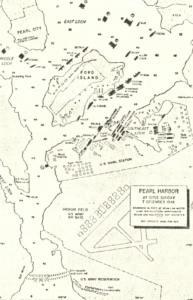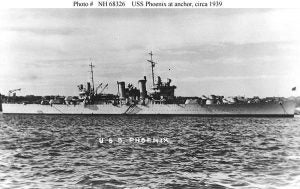Staff Pick: Commander Frank Costagliola Recalls the Attack on Pearl Harbor, Hawaii
This Saturday marks the 78th anniversary of the attack on Pearl Harbor, an event which resulted in the United States declaring war on Japan (December 8, 1941) and her ally Germany (December 11, 1941), solidifying our nation’s official entry into World War II. In retaliation of the attack in American waters, the US began a nearly 4 year assault in the Pacific targeting Japanese-controlled islands and eventually mainland Japan itself. Though Germany would surrender in May 1945, Japan refused to sign for peace until after the catastrophic atomic bombings of Hiroshima and Nagasaki in August of that year.
Here in Joyner Library’s Special Collections are records depicting every stage of this Pacific War, from the attack on Pearl Harbor to the Battle for Midway to recollections of the bombings of Hiroshima and Nagasaki.
Francesco “Frank” Costagliola was a gunnery Ensign aboard the USS Phoenix (CL-46), a Brooklyn-class light cruiser. The Phoenix was moored in Pearl Harbor, Hawaii along with 95 other ships. Among these were eight of the United States’ battleships, “the queens of the Pearl, the mighty tenants of Battleship Row: Pennsylvania, Nevada, Arizona, Tennessee, West Virginia, Maryland, Oklahoma, and California”. The following account is in Francesco Costagliola’s own words, which can be found in his papers here in Joyner Special Collections:

Chart of Pearl Harbor on December 7, 1941. Francesco Costagliola Papers,excerpt from The Rising Sun in the Pacific, 1931-April 1942
“I hated guns and gunnery so I jumped at the chance to go into the engineering department when I reported aboard. About a month before the attack, however, I was transferred to the gunnery department and assigned as operator of the main battery rangekeeper as my primary battle station…
Our ship, which had the primary mission of protecting the battleships from enemy destroyer attacks, was capable of firing more than one hundred 6″ diameter 130 pound shells per minute to a maximum range of about twelve miles.
On the Sunday morning of the attack, the [Phoenix] was in Pearl Harbor moored fore and aft to buoys in the cruiser berthing area northeast of Ford Island near the Aiea landing. We were across the channel about 1000 yards from the nearest battleships which were off our starboard quarter. I got up about 7:30, planning to catch a boat scheduled to leave the ship at 8:15 for church services on one of the battleships. I had planned to later go over to the submarine base and spend a leisurely afternoon at the sub-base swimming pool…
I was in my stateroom at the washbasin just finishing shaving when I thought I heard gunfire. I looked out the porthole. It overlooked the destroyers nested to the west of us. I didn’t see anything unusual. Next I heard the word passed over the ship’s loudspeaker system, “Set condition Three, Watch II in the AA battery.”
The ship’s company, then about 800 officers and men was organized for three battle conditions. In Condition One [or] General Quarters, full battle readiness, in which all guns were fully manned, everyone had a battle station. In Condition Two the ship’s company was divided into two groups, half would be at their condition watch stations while the other half was off. It called for full manning of the antiaircraft battery and partial manning of the main battery. In Condition Three the ship’s company was divided into four groups, four watch sections. One watch section would be at their Condition Three stations and the other three sections off.
In this battle readiness condition no main battery stations were manned but the antiaircraft battery which consisted of eight 5″ guns… was fully manned. The AA battery also included two manually operated 3″ guns and about four .50 caliber machine guns…
On December 7, 1941 the second section (Watch II) had the duty. I was in the fourth duty section so the call for condition Three, Watch II did not affect me.
I was standing in my underwear putting away my shaving gear when Warrant Boatswain Bergstad came banging on my door. He was going around to all the officer’s staterooms. He said, ‘Mr. Costagliola, Mr. Costagliola, the Japs are attacking.’ Stunned, my first reaction was what clothes shall I put on? I had two choices: white service, the uniform of the day, which consisted of long white starched trousers and a stiff starched white blouse with high collar and removable brass buttons, or, since I had been in engineering, blue work shirt and dungarees. I opted for the dungarees. There didn’t seem to be any point in going to the main battery rangekeeper in the plotting room so I headed for my condition three station as rangekeeper operator in the after AA director to see if I could be of any help there.
On my way to the after AA director as I crossed the quarterdeck I passed the officer-of-the-deck, Hugh Hanna, an Ensign a year senior to me. He said,’Dammit Costy do something, put on your .45′. In a sort of trance, I automatically turned and went back to my stateroom, put on my .45 and proceeded back up to the after AA director.
The director was fully manned so I wasn’t needed there. I looked around. Almost directly astern, across the channel from us, a battleship was burning. Flames were shooting into the air. A tremendous column of black smoke was rising from it. It was the U.S.S. Arizona. I remember a lone Japanese plane passing almost overhead on our port quarter about a thousand feet up. Chief Gunners Mate Baratz was firing at it with one of our two three inch guns. I also remember a flame on the water in the channel between us and the Arizona. I can only surmise that it was a burning remnant from a Japanese plane that had been shot down.
Hugh Hanna who was now in the director in his regular Condition Three, Watch II station as control officer called down to me to haul down the Sunday colors because they were getting in the line of sight of the director. On Sundays in port we always flew a very large flag from the mainmast. As we started to comply I mentioned to 1st class Firecontrolman Williams who came to help me, the thought that this might indicate to the Japanese we were surrendering. Williams suggested we run it up on the yardarm where it would be out of the way. This we did.
The next thing I recall was seeing a flight of Japanese high altitude bombers through the scattered white clouds in the direction of the shipyard and Hickam Field, approaching from the south. They passed well to starboard of us and our shooting didn’t have any apparent effect. They were probably too far away for our guns.
Then I recall seeing one of our B-17 bombers on our starboard side and it looked as though some of our starboard AA guns were shooting at it. I yelled up to Hanna that we were shooting at one of our B-17s. He told me to go down to the starboard battery and tell the gunners to shoot only at airplanes with red circles under their wings. I did that and while there learned that ammunition in the ready boxes was expended and there was a problem getting more ammo from the magazines. So I started to look into it.
I went down to the ammunition transfer station which was in the living compartment of our Marine Detachment. It was located under the forward superstructure and its floor was the armored deck. Ammunition came up from the magazine in hoists through the armored deck and then was transferred by hand to other hoists that took it up to the guns. By the time I arrived in the transfer station the problem had been solved and the ammunition flow was satisfactory. However, since this was a critical spot and there was no officer there, I decided to stay there in case new problems developed. There was sporadic firing over the next hour or more. All kinds of rumors, mostly false, were coming over the radio from a Honolulu station…
To refresh you on the statistics 2008 Navy men were killed, 109 Marines, 218 Army including Army Air Forces personnel and 68 civilians died for a total of 2,403. Another 1,178 people were wounded. Every battleship, there were eight of them, was put out of action. Of the six battle force cruisers in the harbor, three were put out of action. Three destroyers and three auxiliary vessels were also put out of action. The Navy lost 13 fighters, 25 bombers and 46 patrol planes. The Army Air Force lost fifty nine fighters and eighteen bombers. There was extensive damage to shore installations of both services, particularly aviation facilities at various places on Oahu. If any aircraft carriers had been in, I am sure they would have been put out of action also.”
Sources:
- Francesco Costagliola Papers (#591), East Carolina Manuscript Collection, J. Y. Joyner Library, East Carolina University, Greenville, North Carolina, USA.
- Francesco Costagliola oral history interview, March 30, 1990 and February 7, 1995, East Carolina Manuscript Collection, J. Y. Joyner Library, East Carolina University, Greenville, North Carolina, USA.
- Nelson, Craig. Pearl Harbor: From Infamy to Greatness. New York: Scriber, 2016.
- Evans, Mark L. Phoenix III (CL-46), 1938-1946. Naval History and Heritage Command, 2019.
- USS Phoenix (CL-46): Light Cruiser. Obtained from militaryfactory.com
